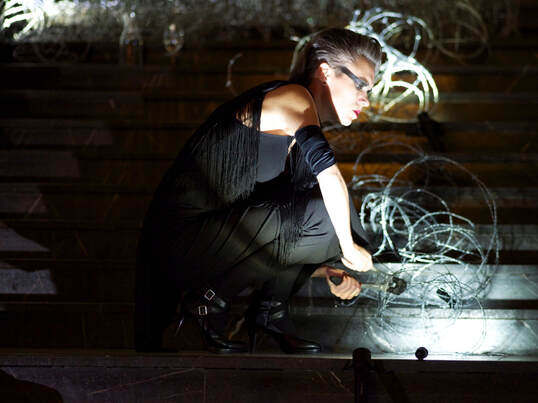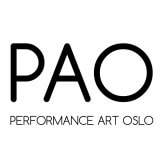Interview with Johanna Zwaig
 I’LL REPEAT THIS SONG UNTIL I’M KICKED OUT // One Night Only, Høstutstillingen, Kunstnernes Hus 2013. Photo: Tito Frey
I’LL REPEAT THIS SONG UNTIL I’M KICKED OUT // One Night Only, Høstutstillingen, Kunstnernes Hus 2013. Photo: Tito Frey
Oslo, 31 October 2019
Q: Why / when / how did you start to work with performance, what is your background, how did you arrive at doing performance?
I have my background from Ecole Internationale de Théâtre, Jacques Lecoq in Paris, the University of Oslo, and I’ve studied flamenco in Paris, Madrid, Sevilla and Jerez de la Frontera. From an early age I worked professionally with theatre and dance, but after a while I turned to performance art, inspired by its wild, rebellious roots and its history of experimental will. I wanted to leave the traditional stage format, I wanted to set the audience free, and I wanted to “do” and “be”, not play. Some of my first performances were out in public space, like in front of Parliament in 2001 at the International day against violence against women. Then in 2006 I did my first long durational performance, ARENA – PERFORMANCE WITH LORCA, at the Henie Onstad Art Centre.
Q: With what kind of form / material do you express yourself and use in your work and how did you arrive at using this material?
For several years now I’ve been working with flamenco song in combination with symbolic actions and objects. I’ve been focusing on the darkest forms, learnt in the barrios gitanos of Jerez de la Frontera. I’ve been interested in songs loaded with old screams against injustice, and in what might happen when I move these songs to new contexts of injustice. It is as if they contain a memory of former suffering and fight.
In my long durational performances I often repeat one song and one action for hours. The action might leave traces or slowly change an installation. I’ve been interested in the protest aspect of repetition, but also in how repetition might create concentrated rooms for reflection.
Q: How do you experience or consider the audience / surrounding? What space / surrounding do you find interesting to work in? How does your surrounding influence your work? Do you involve the public? If so, how?
I usually do my long durational performances in art halls, museums and galleries. I’m interested in creating rooms where the audience can feel free to come and go and move around as they like, as in an exhibition. The result is often that they sit down and stay, sometimes for hours. I also do shorter performances outdoors in public spaces. I think the unexpected encounters, and the disturbance or surprises these performances might create, are really interesting. But in all my work I want the audience to feel free. It’s up to them whether they want to come close.
Q: What are you investigating right now?
Right now I’m investigating a wider range of songs, from French chansons and Argentinian tango to old Andalusian songs, klezmer and Russian gypsy music. I’m especially interested in songs of resistance and songs of protest, but also in how we can connect with each other through songs, how they might create cracks in walls.
<< Back
